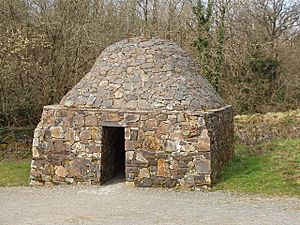Clochán facts for kids
A clochán, also known as a beehive hut, is a special type of stone house. It is built using dry-stone techniques, meaning stones are stacked carefully without any mortar. The roof is shaped like a dome, using a method called corbelling. This is where each stone sticks out a little further than the one below it.
These unique buildings are mostly found along the southwest coast of Ireland. We don't know exactly when most clocháns were built. They are part of a very old Celtic building tradition. Some clocháns might be from around 700 AD or even earlier. Many were used by monks, especially those linked to religious places. Some of the best-preserved ones might be from the 12th century or later.
How Beehive Huts Were Built
Most clocháns are round, like a beehive. However, some have a rectangular shape. Experts think the rectangular ones might have been built later. Not all clocháns were made entirely of stone. Some might have had a roof made of thatch instead of stone.
The walls of these huts are very thick. They can be up to 1.5 meters (about 5 feet) wide. Sometimes, several clocháns are built right next to each other. Their thick walls join them together.
Where to Find Beehive Huts
You can find clocháns mainly in the Southwest of Ireland. Famous places to see them include Skellig Michael and Church Island, near Beginish Island. They are also found at Glanfahan, Fahan, and Reask on the Dingle Peninsula in County Kerry.
Many clocháns were used by monks. These monks followed Saint Patrick and helped spread Christianity. The building style was also carried to other places. Monks built similar structures on the Scottish island of Iona. Later, through Aidan, the tradition reached the eastern English islands of Farne and Holy Island.
Some clocháns are found inside ringforts. Ringforts are old circular forts. These clocháns, like those at Leacanabuaile in County Kerry, were likely homes for ordinary people. Even impressive stone churches, such as the Gallarus Oratory, might have been inspired by the clochán design.
See also
In Spanish: Clochán para niños



